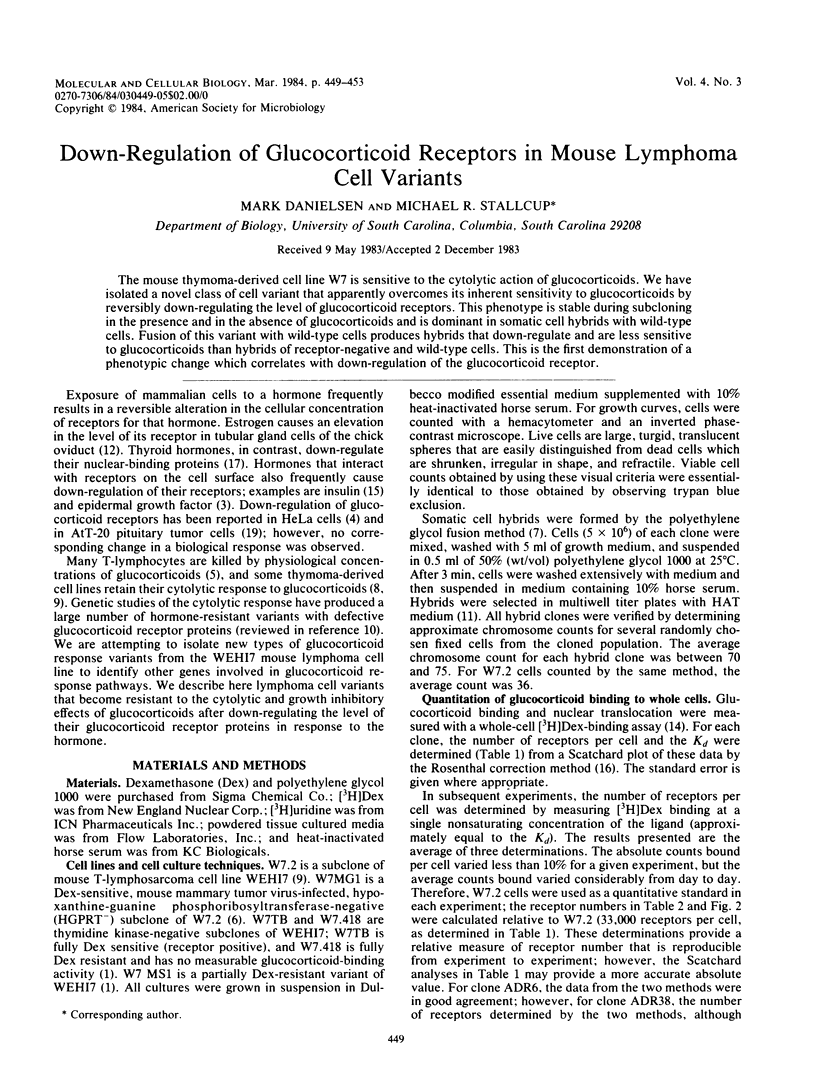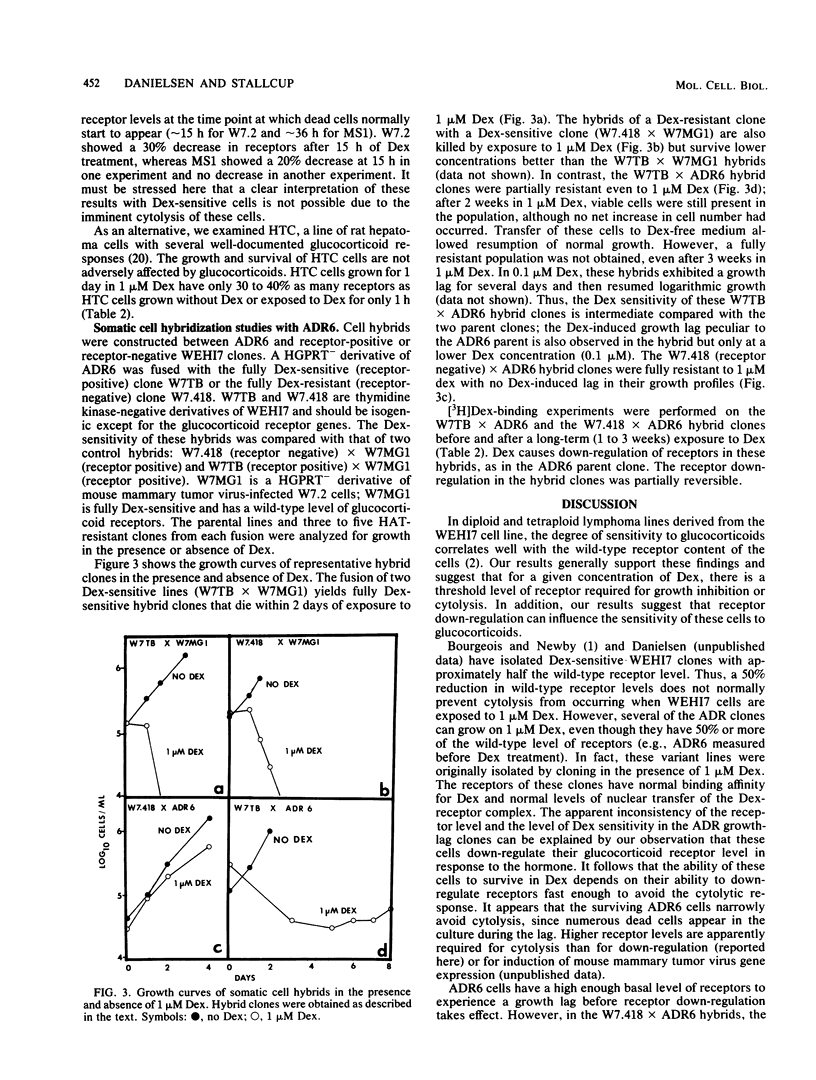Abstract
The mouse thymoma-derived cell line W7 is sensitive to the cytolytic action of glucocorticoids. We have isolated a novel class of cell variant that apparently overcomes its inherent sensitivity to glucocorticoids by reversibly down-regulating the level of glucocorticoid receptors. This phenotype is stable during subcloning in the presence and in the absence of glucocorticoids and is dominant in somatic cell hybrids with wild-type cells. Fusion of this variant with wild-type cells produces hybrids that down-regulate and are less sensitive to glucocorticoids than hybrids of receptor-negative and wild-type cells. This is the first demonstration of a phenotypic change which correlates with down-regulation of the glucocorticoid receptor.
Full text
PDF




Selected References
These references are in PubMed. This may not be the complete list of references from this article.
- Bourgeois S., Newby R. F. Correlation between glucocorticoid receptor and cytolytic response of murine lymphoid cell lines. Cancer Res. 1979 Nov;39(11):4749–4751. [PubMed] [Google Scholar]
- Bourgeois S., Newby R. F. Diploid and haploid states of the glucocorticoid receptor gene of mouse lymphoid cell lines. Cell. 1977 Jun;11(2):423–430. doi: 10.1016/0092-8674(77)90060-5. [DOI] [PubMed] [Google Scholar]
- Carpenter G., Cohen S. 125I-labeled human epidermal growth factor. Binding, internalization, and degradation in human fibroblasts. J Cell Biol. 1976 Oct;71(1):159–171. doi: 10.1083/jcb.71.1.159. [DOI] [PMC free article] [PubMed] [Google Scholar]
- Cidlowski J. A., Cidlowski N. B. Regulation of glucocorticoid receptors by glucocorticoids in cultured HeLa S3 cells. Endocrinology. 1981 Dec;109(6):1975–1982. doi: 10.1210/endo-109-6-1975. [DOI] [PubMed] [Google Scholar]
- Claman H. N. Corticosteroids and lymphoid cells. N Engl J Med. 1972 Aug 24;287(8):388–397. doi: 10.1056/NEJM197208242870806. [DOI] [PubMed] [Google Scholar]
- Danielsen M., Peterson D. O., Stallcup M. R. Immunological selection of variant mouse lymphoid cells with altered glucocorticoid responsiveness. Mol Cell Biol. 1983 Jul;3(7):1310–1316. doi: 10.1128/mcb.3.7.1310. [DOI] [PMC free article] [PubMed] [Google Scholar]
- Gefter M. L., Margulies D. H., Scharff M. D. A simple method for polyethylene glycol-promoted hybridization of mouse myeloma cells. Somatic Cell Genet. 1977 Mar;3(2):231–236. doi: 10.1007/BF01551818. [DOI] [PubMed] [Google Scholar]
- Harris A. W., Bankhurst A. D., Mason S., Warner N. L. Differentiated functions expressed by cultured mouse lymphoma cells. II. Theta antigen, surface immunoglobulin and a receptor for antibody on cells of a thymoma cell line. J Immunol. 1973 Feb;110(2):431–438. [PubMed] [Google Scholar]
- Harris A. W. Differentiated functions expressed by cultured mouse lymphoma cells. I. Specificity and kinetics of cell responses to corticosteroids. Exp Cell Res. 1970 Jun;60(3):341–353. doi: 10.1016/0014-4827(70)90527-6. [DOI] [PubMed] [Google Scholar]
- LITTLEFIELD J. W. SELECTION OF HYBRIDS FROM MATINGS OF FIBROBLASTS IN VITRO AND THEIR PRESUMED RECOMBINANTS. Science. 1964 Aug 14;145(3633):709–710. doi: 10.1126/science.145.3633.709. [DOI] [PubMed] [Google Scholar]
- Mulvihill E. R., Palmiter R. D. Relationship of nuclear estrogen receptor levels to induction of ovalbumin and conalbumin mRNA in chick oviduct. J Biol Chem. 1977 Mar 25;252(6):2060–2068. [PubMed] [Google Scholar]
- Pfahl M., Kelleher R. J., Jr, Bourgeois S. General features of steroid resistance on lymphoid cell lines. Mol Cell Endocrinol. 1978 Apr;10(2):193–207. doi: 10.1016/0303-7207(78)90125-9. [DOI] [PubMed] [Google Scholar]
- Pfahl M., Sandros T., Bourgeois S. Interaction of glucocorticoid receptors from lymphoid cell lines with their nuclear acceptor sites. Mol Cell Endocrinol. 1978 Apr;10(2):175–191. doi: 10.1016/0303-7207(78)90124-7. [DOI] [PubMed] [Google Scholar]
- Ronnett G. V., Knutson V. P., Lane M. D. Insulin-induced down-regulation of insulin receptors in 3T3-L1 adipocytes. Altered rate of receptor inactivation. J Biol Chem. 1982 Apr 25;257(8):4285–4291. [PubMed] [Google Scholar]
- Samuels H. H., Stanley F., Shapiro L. E. Modulation of thyroid hormone nuclear receptor levels by 3,5,3'-triiodo-L-thyronine in GH1 cells. Evidence for two functional components of nuclear-bound receptor and relationship to the induction of growth hormone synthesis. J Biol Chem. 1977 Sep 10;252(17):6052–6060. [PubMed] [Google Scholar]
- Schlechte J. A., Ginsberg B. H., Sherman B. M. Regulation of the glucocorticoid receptor in human lymphocytes. J Steroid Biochem. 1982 Jan;16(1):69–74. doi: 10.1016/0022-4731(82)90145-5. [DOI] [PubMed] [Google Scholar]
- Svec F., Rudis M. Glucocorticoids regulate the glucocorticoid receptor in the AtT-20 cell. J Biol Chem. 1981 Jun 25;256(12):5984–5987. [PubMed] [Google Scholar]
- Thompson E. B., Granner D. K., Gelehrter T., Erickson J., Hager G. L. Unlinked control of multiple glucocorticoid-induced processes in HTC cells. Mol Cell Endocrinol. 1979 Sep;15(3):135–150. doi: 10.1016/0303-7207(79)90034-0. [DOI] [PubMed] [Google Scholar]


